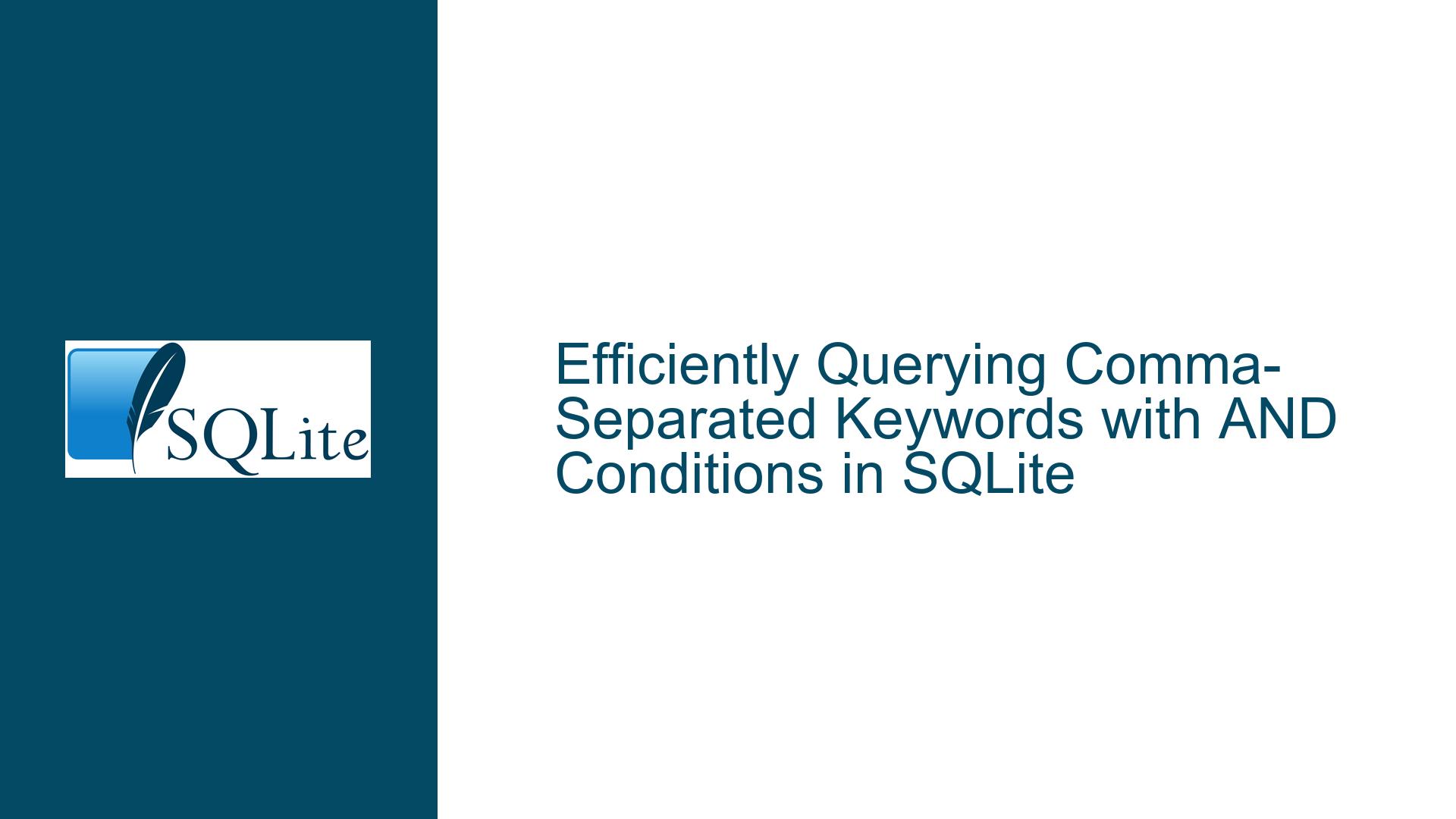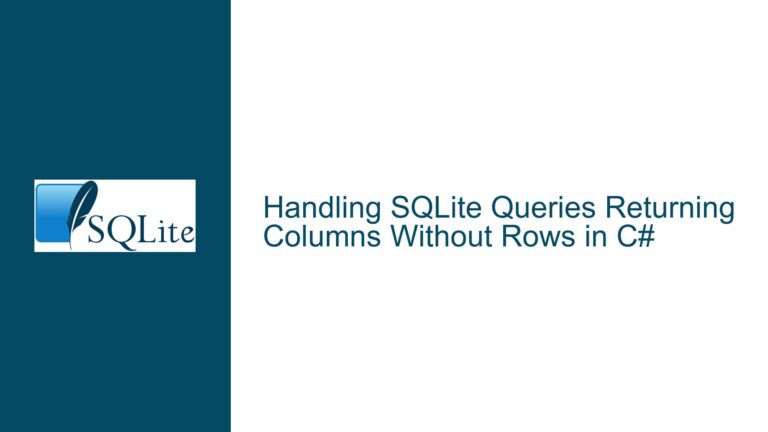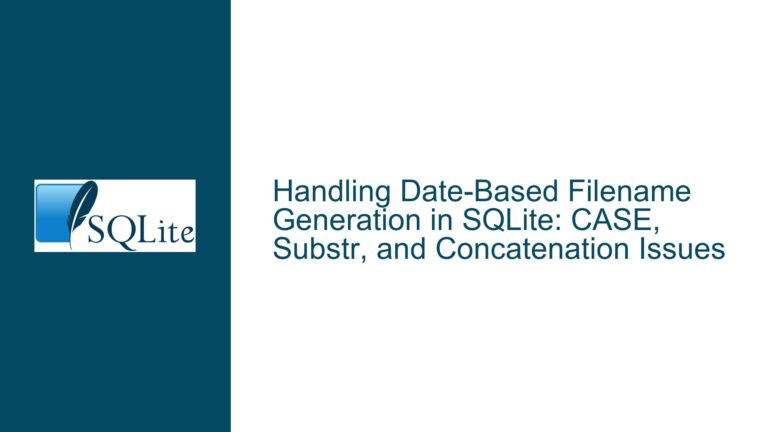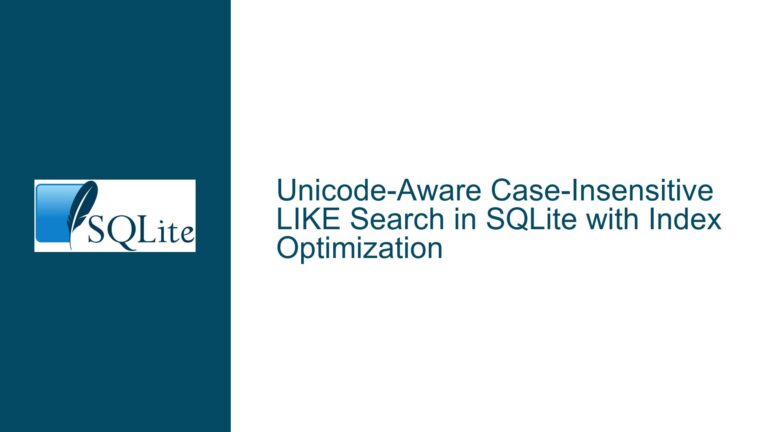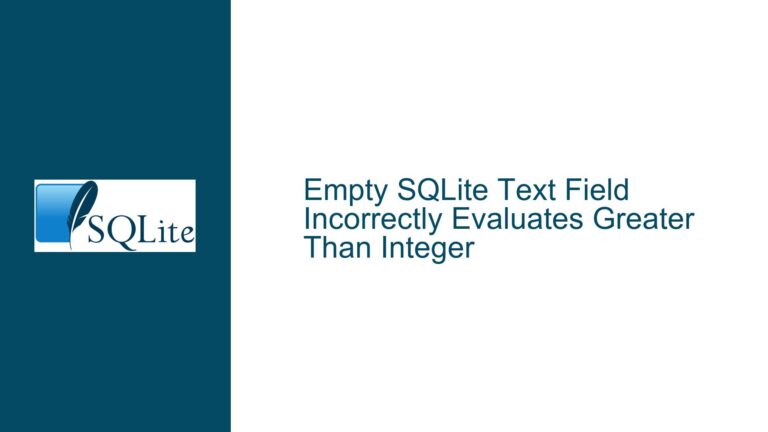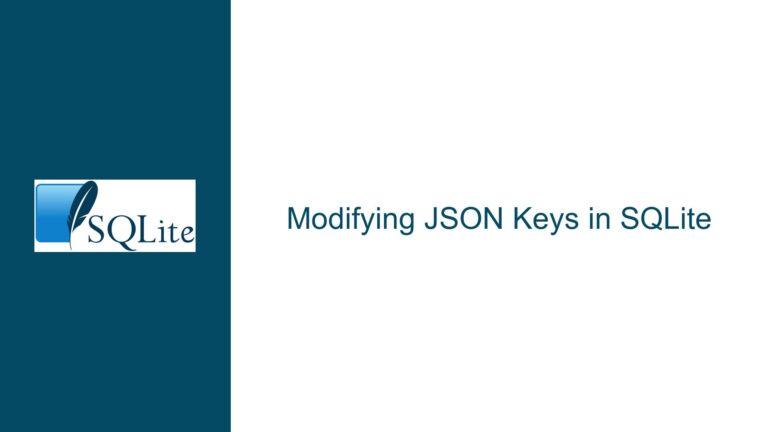Efficiently Querying Comma-Separated Keywords with AND Conditions in SQLite
Understanding Challenges with Keyword Matching in Denormalized String Columns
The core challenge revolves around querying records where a column contains comma-separated keywords, with the requirement to enforce logical AND conditions across multiple keywords. This scenario arises frequently in applications that store tags, categories, or attributes as a single string (e.g., 'computer-sci,programming,c'). While SQLite provides string manipulation functions like LIKE and INSTR, these methods often lead to unreliable results due to substring mismatches, improper delimiter handling, or inefficient execution plans. Additionally, the absence of a normalized schema (e.g., using junction tables) exacerbates performance and correctness issues as datasets grow.
The problem is compounded by edge cases such as single-keyword entries (e.g., 'c') or overlapping keyword substrings (e.g., 'c' vs. 'crab'). A naive approach using LIKE '%c%' would incorrectly match both 'c' and 'crab', while failing to enforce strict AND logic across multiple required keywords. The discussion highlights three primary strategies: (1) string-based pattern matching with delimiter safeguards, (2) recursive CTEs for keyword tokenization, and (3) schema normalization via junction tables. Each approach has trade-offs in accuracy, maintainability, and scalability.
Root Causes of Keyword Query Inefficiency and Incorrect Results
1. Substring Collisions in Delimiter-Free Patterns
The LIKE operator and INSTR function without proper delimiter handling cause unintended matches. For example, searching for 'c' in 'crab' using LIKE '%c%' returns a false positive. Similarly, INSTR(Keywords, 'c') > 0 fails to distinguish standalone keywords from substrings. This occurs because the absence of delimiter checks (e.g., commas) allows partial matches to satisfy conditions.
2. Inadequate Handling of Edge Cases in Comma-Separated Strings
When keywords are stored as comma-separated strings, edge cases such as single-keyword entries ('c'), leading/trailing commas, or inconsistent spacing break basic pattern-matching logic. For instance, a query designed to match 'c' using INSTR(',c,', ',c,') works for standalone keywords but fails if the stored string lacks enclosing commas or contains irregular spacing (e.g., 'c ,d').
3. Lack of Schema Normalization for Many-to-Many Relationships
Storing multiple keywords in a single column violates First Normal Form (1NF), leading to inefficient query execution. Without a junction table linking records to individual keywords, SQLite must repeatedly parse and tokenize the comma-separated string for each query. This results in O(n*m) complexity for n records and m keywords, degrading performance as data scales.
4. Recursive CTE Misapplication for AND Logic
Recursive Common Table Expressions (CTEs) can split comma-separated strings into individual tokens, but aggregating these tokens to enforce AND conditions requires additional logic. A naive recursive CTE may generate a list of tokens without associating them with their parent record, making it impossible to verify that all required keywords exist for a given row.
Step-by-Step Solutions for Reliable Keyword Queries
Solution 1: Delimiter-Aware String Matching with INSTR or LIKE
This approach wraps keywords and search terms in commas to enforce exact matches, avoiding substring collisions. For example, to find rows containing both 'computer-sci' and 'c':
SELECT id, keywords FROM entries
WHERE
instr(',' || keywords || ',', ',computer-sci,') > 0
AND instr(',' || keywords || ',', ',c,') > 0;
Key Steps:
- Normalize Stored Keywords: Ensure all entries are comma-separated without spaces (e.g.,
'computer-sci,systems'). - Wrap Keywords and Terms in Commas: This turns
'c'into',c,', preventing matches with'crab'or'c-sharp'. - Combine Conditions with
AND: Each required keyword becomes a separateINSTRorLIKEcondition.
Limitations:
- Requires consistent keyword formatting (no spaces, trailing commas).
- Performance degrades with many
ANDconditions due to repeated full-string scans.
Solution 2: Recursive CTE for Tokenization and Aggregation
A recursive CTE can split keywords into tokens and then validate that all required tokens exist for a record. This method is more flexible but requires intermediate SQL skills.
WITH RECURSIVE split_tokens(id, token, remaining) AS (
SELECT
id,
substr(keywords || ',', 0, instr(keywords || ',', ',')),
substr(keywords || ',', instr(keywords || ',', ',') + 1)
FROM entries
UNION ALL
SELECT
id,
substr(remaining, 0, instr(remaining, ',')),
substr(remaining, instr(remaining, ',') + 1)
FROM split_tokens
WHERE remaining != ''
)
SELECT id
FROM split_tokens
WHERE token IN ('computer-sci', 'c')
GROUP BY id
HAVING COUNT(DISTINCT token) = 2;
Key Steps:
- Tokenize Keywords: The CTE splits each comma-separated string into individual tokens.
- Filter Tokens: Retain only tokens matching the required keywords (
'computer-sci','c'). - Aggregate by Record: Use
GROUP BY idandHAVING COUNT(DISTINCT token)to enforceANDlogic.
Limitations:
- Recursive CTEs can be slow for large datasets.
- Requires SQLite 3.8.3+ for CTE support.
Solution 3: Schema Normalization with Junction Tables
This is the most scalable and maintainable approach. It involves creating two new tables: one for unique keywords and another linking keywords to records.
Step 1: Create Normalized Tables
CREATE TABLE keywords (
keyword_id INTEGER PRIMARY KEY,
keyword TEXT UNIQUE
);
CREATE TABLE entry_keywords (
entry_id INTEGER,
keyword_id INTEGER,
FOREIGN KEY(entry_id) REFERENCES entries(id),
FOREIGN KEY(keyword_id) REFERENCES keywords(keyword_id)
);
Step 2: Migrate Existing Data
Use a recursive CTE or application logic to split existing comma-separated keywords and populate the normalized tables.
-- Using recursive CTE for migration
WITH RECURSIVE split(keyword, remaining, entry_id) AS (
SELECT
substr(keywords || ',', 0, instr(keywords || ',', ',')),
substr(keywords || ',', instr(keywords || ',', ',') + 1),
id
FROM entries
UNION ALL
SELECT
substr(remaining, 0, instr(remaining, ',')),
substr(remaining, instr(remaining, ',') + 1),
entry_id
FROM split
WHERE remaining != ''
)
INSERT INTO keywords (keyword)
SELECT DISTINCT keyword FROM split WHERE keyword != '';
INSERT INTO entry_keywords (entry_id, keyword_id)
SELECT split.entry_id, keywords.keyword_id
FROM split
JOIN keywords ON split.keyword = keywords.keyword
WHERE split.keyword != '';
Step 3: Query Using JOINs
To find entries with both 'computer-sci' and 'c':
SELECT e.id, e.keywords
FROM entries e
JOIN entry_keywords ek1 ON e.id = ek1.entry_id
JOIN keywords k1 ON ek1.keyword_id = k1.keyword_id AND k1.keyword = 'computer-sci'
JOIN entry_keywords ek2 ON e.id = ek2.entry_id
JOIN keywords k2 ON ek2.keyword_id = k2.keyword_id AND k2.keyword = 'c';
Optimizations:
- Add indexes on
keywords.keywordandentry_keywords.entry_id. - Use
INTERSECTfor cleanerANDlogic:SELECT entry_id FROM entry_keywords JOIN keywords USING (keyword_id) WHERE keyword = 'computer-sci' INTERSECT SELECT entry_id FROM entry_keywords JOIN keywords USING (keyword_id) WHERE keyword = 'c';
Advantages:
- Eliminates substring collisions.
- Enables efficient indexing and
JOINoperations. - Supports additional features like keyword counts or weighted tags.
Comparative Analysis and Decision Guide
| Criterion | String Matching | Recursive CTE | Normalized Schema |
|---|---|---|---|
| Accuracy | Moderate | High | High |
| Performance | Poor (O(n)) | Moderate (O(n)) | High (O(log n)) |
| Maintainability | Low | Moderate | High |
| Scalability | Limited | Limited | High |
| Implementation Complexity | Low | Moderate | High |
Recommendations:
- Small Datasets: Use delimiter-aware string matching for simplicity.
- Moderate Datasets: Recursive CTEs offer a balance between correctness and complexity.
- Large-Scale Applications: Normalize the schema for optimal performance and flexibility.
By methodically addressing delimiter handling, leveraging SQLite’s recursive capabilities, and advocating for schema normalization, developers can achieve reliable and efficient keyword queries tailored to their application’s scale and requirements.
